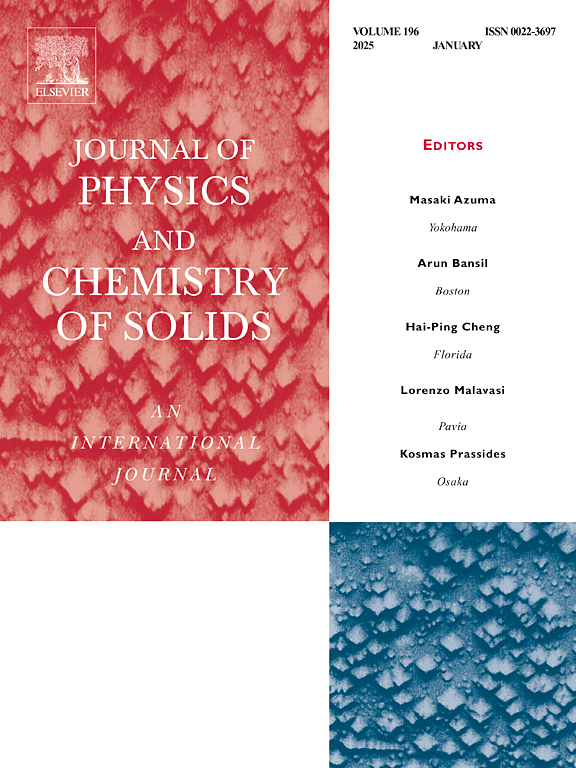Adsorption mechanism of Phosgene gas onto the pristine hBN and Cu-decorated hBN: A DFT study
IF 4.3
3区 材料科学
Q2 CHEMISTRY, MULTIDISCIPLINARY
引用次数: 0
Abstract
The adsorption behavior of pristine hBN monolayer and Cu-decorated hBN monolayer towards the detection of toxic gas such as COCl2 were explored using the first principle calculations based on Density Functional Theory (DFT). The calculated low adsorption energy for the A4 configurations indicates that the interaction of the COCl2 gas with pristine hBN was weak, resulting in poor recovery time. Therefore, to enhance the adsorption affinity of hBN, the Cu atom was adsorbed onto the surface of hBN (Cu-hBN) and substitutionally doped (Cu-doped hBN). It was based on energy minimization, and B2 and C2 configurations were the most stable configurations among the different adsorption configurations. The adsorption study revealed that strong chemical interaction exists, and the adsorption of COCl2 gas onto Cu-hBN and Cu-doped hBN was a chemisorption. Further, various calculations such as DOS, Hirshfeld atomic charge, charge density differences, ELF, and RDG were calculated for the most stable configurations. The resulting DOS plot revealed that the COCl2 adsorption enhances the electrical conductivity due to the 72.25 % and 54.13 % reduction in the band gap. Hirshfeld and ELF analysis showed that substantial charge transfer occurs in the case of B2 and C2 compared to A4 configurations. ELF analysis revealed that the Cu atom loses electrons to the COCl2, confirming the behavior of adsorbates as electron donors and COCl2 as electron acceptors. Furthermore, RDG analysis revealed vdW interaction in the case of A4, whereas strong, attractive interaction exists in the case of B2 and C2 adsorption configurations. Finally, the calculated recovery time for B2 and C2 adsorption configurations at elevated temperatures under visible light suggests that Cu-doped hBN and Cu-hBN systems can be utilized as a sensing material in gas sensors to detect COCl2 gas at high temperatures.
光气气体在原始hBN和cu修饰hBN上的吸附机理:DFT研究
利用基于密度泛函理论(DFT)的第一性原理计算,探讨了原始hBN单层和cu修饰hBN单层对COCl2等有毒气体的吸附行为。A4构型的低吸附能表明,COCl2气体与原始hBN的相互作用较弱,导致回收时间较短。因此,为了增强hBN的吸附亲和力,将Cu原子吸附在hBN表面(Cu-hBN)并进行取代掺杂(Cu-掺杂hBN)。以能量最小化为基础,B2和C2是不同吸附构型中最稳定的构型。吸附研究表明存在强的化学相互作用,COCl2气体在Cu-hBN和cu掺杂hBN上的吸附为化学吸附。此外,对最稳定的构型进行了DOS、Hirshfeld原子电荷、电荷密度差、ELF和RDG等计算。DOS图显示,COCl2的吸附使带隙减小了72.25%和54.13%,从而提高了导电性能。Hirshfeld和ELF分析表明,与A4构型相比,B2和C2构型发生了大量的电荷转移。ELF分析表明Cu原子失去电子给COCl2,证实了吸附物作为电子给体和COCl2作为电子受体的行为。此外,RDG分析显示,在A4的情况下存在vdW相互作用,而在B2和C2的吸附构型中存在强的吸引相互作用。最后,在可见光下计算出B2和C2在高温下吸附构型的恢复时间,这表明cu掺杂hBN和Cu-hBN体系可以作为气体传感器中检测高温下COCl2气体的传感材料。
本文章由计算机程序翻译,如有差异,请以英文原文为准。
求助全文
约1分钟内获得全文
求助全文
来源期刊
CiteScore
7.80
自引率
2.50%
发文量
605
审稿时长
40 days
期刊介绍:
The Journal of Physics and Chemistry of Solids is a well-established international medium for publication of archival research in condensed matter and materials sciences. Areas of interest broadly include experimental and theoretical research on electronic, magnetic, spectroscopic and structural properties as well as the statistical mechanics and thermodynamics of materials. The focus is on gaining physical and chemical insight into the properties and potential applications of condensed matter systems.
Within the broad scope of the journal, beyond regular contributions, the editors have identified submissions in the following areas of physics and chemistry of solids to be of special current interest to the journal:
Low-dimensional systems
Exotic states of quantum electron matter including topological phases
Energy conversion and storage
Interfaces, nanoparticles and catalysts.

 求助内容:
求助内容: 应助结果提醒方式:
应助结果提醒方式:


